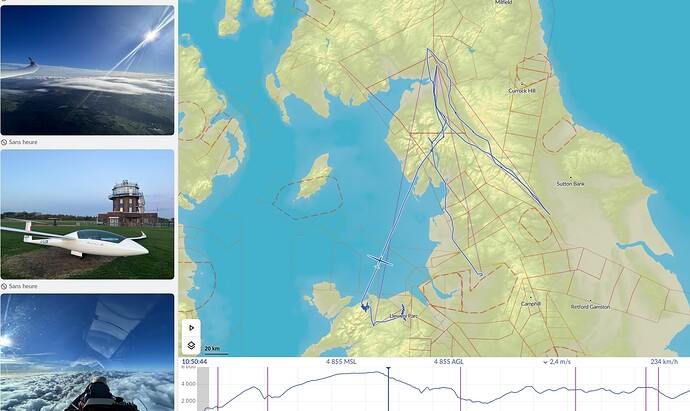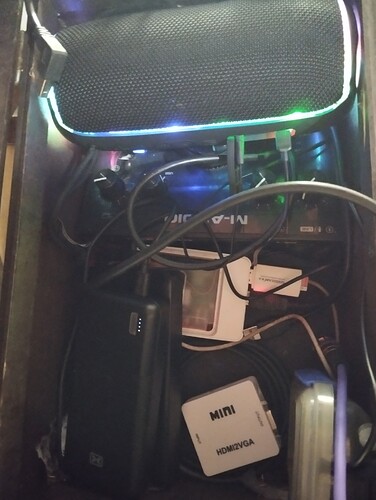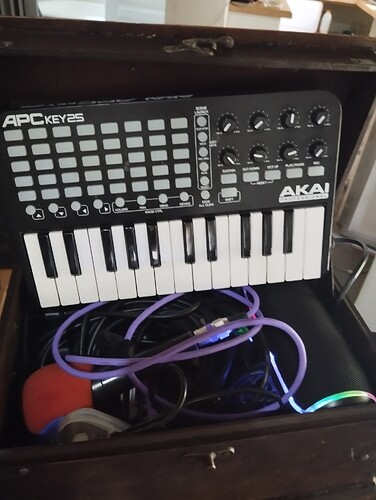Nothing diverts quite like a zynthian thread. . . .
how much that is true ! I think my today’s afternoon is more or less dead unproductive.
but beautiful flights are possible
We didn’t have anything that slick …!
I did the silver in an AS21. . . Booker to Lasham. Very much a milk run, but a lot of fun out over the Oxford plain, and racing high performance cars on the A40 . .
I also tended to get headaches at height. I was flown at zell am zee which was very interesting to someone who was used to the flat lands of East Anglia…
Landscape, shouldn’t be up from a launch…
The box with 2 power banks hardware clock pi5 hdmi to VGA and audio interface
Just updated the hardware clock code for extra smooth stability ![]()
Also updated the driver for the apc25 to set some sl settings off the bat
I had an original zynth rig that fitted in a rucksack so I could cycle to a gig…
How frequently do you perform?
Wondering what settings you always set.
For me, it’s currently only smart_eighths (turning it off), since I like sometimes to be able to sync to half or a quarter of a loop.
i’ve been playing around with sooperlooper and zynseq a bit as well and agree with @lanmower that the zynthian can pretty much blow most loopers out of the water in terms of pure functionality. what im currently struggeling with though is to figure out how to effectively “group” loops. so that i can set up A / B sections or chorus / verse with for example guitar, bass, percussion for each group or section. i know this for sure possible with OSC and/or external midi controllers + drivers. i have a midi foot controller (because of the guitar) and would like to keep the complexity inside zynthian instead of configuring the midi controller to much.
is there an obvious best way to set this up? i feel like i’m missing something.
im also trying to do something similar with the zynseq sequencer and want to eventually want to combine audio and midi looping in some way. i think i read someone in the forum asking about this as well, but i can’t find it anymore. found the github feature request though Starting an entire Pad row in the ZynSeq at once · Issue #417 · zynthian/zynthian-issue-tracking · GitHub
also what i found is that when assigning trigger note, scrolling past a note thats assigned to another pad, deletes the assignment. when being careful about the order of operation i can configure my midi controller to output two (or more) notes which then trigger a row (or group / section / verse) of pads.
i tried the zynsampler as a zynseq pad as well, which seems super promising as well. while the individual loop might have as much features as a sooperlooper loop it would be very nicely integrated with MIDI loops within the zynseq sequencer. this might already work perfectly for all i know, since i just tested it for 5min a while ago.
so, similar kind of question here: is there an obvious way to setup triggering multiple pads and/or combining MIDI pads with audio pads (using zynsampler)?
either way i think there is still a lot of cool stuff to figure out in terms of what the zynthian can do with loops ![]()
Only tangentially related but this reminds me of what an auto-accompaniment system needs too.
liblo.send(self.osc_target, "/set", "sync_source", -2) # Set sync source to MIDI
liblo.send(self.osc_target, "/set", "eighth_per_cycle", 4) # Set cycle length to 4 8ths per cycle
# Configure settings for all loops
liblo.send(self.osc_target, "/sl/-1/set", "quantize", 1) # Set quantize to cycle
liblo.send(self.osc_target, "/sl/-1/set", "playback_sync", 1) # Set playback_sync on
liblo.send(self.osc_target, "/sl/-1/set", "sync", 1) # Set sync on
liblo.send(self.osc_target, "/sl/-1/set", "relative_sync", 0) # Set rel_sync off
not too much right now, I want to clear my sooperlooper template and make it work from-scratch, will be testing that soone
Here’s the driver I tested last night on stage
Think Like a Loop Artist
Focus on mute groups instead of traditional DAW channels or effect groups.
1. Arrangement as Channels
SIngers and artists transitioning from other formats to loops would enjoy this, the loops are sections of the arrangement
Steps:
-
Start with a Solid Beat:
- Use a metronome or hardware clock (e.g., Link-ESP GitHub).
- Record a 4 or 8-bar blank beat for timing.
-
Create the Verse:
- Length: 32 or 64 beats.
- Record the verse part.
- Use the “multiply” feature to duplicate it.
- Play in silences if any elements need muting.
-
Build the Chorus:
- Layer in more dynamic elements, like hi-hats and additional instruments.
- Build from shorter loops since choruses are more repetitive.
-
Driver Functionality for Cycling:
- Configure the driver to cycle through different loops.
- Assign a button to cycle loop states (e.g., Loop 1 to Loop 2).
- It might be possible to make the driver do that when the cycle reaches the end automatically, so that it plays the loopers in sequence for automatic cycling between loops after a set duration.
2. Looper as an Instrument
Showcase the flexibility of loopers.
Steps:
- Organize Tracks by Dynamics:
- Create separate tracks for:
- Bass (and brush)
- Snare (and clav)
- Kick (and organ)
- Hi-Hat (and shakers)
- Ride (and rises, and psychedelics from intro)
- Create separate tracks for:
So you can see here you group by darkness and transients since those elements get muted and added back in together, this is the core of how your controls will then work because your sections are combinations of mutes and unmutes.
-
Layer Sounds:
- Start with short elements: record some hi-hats or shakers first to make a louder metronome
- Layer rides and rises to establish song boundaries.
- Keep kick and bass on separate tracks for arrangement clarity.
-
Create an Engaging Performance:
- Start with playing the bass, record for 16 beats, then wait.
- Add the snare after the bass and wait another 16 beats.
- Continue this sequence, adding elements to maintain dynamics.
- Mute and unmute channels based on performance intensity. Start with foundational elements, then build complexity.
- Show the audience when buttons are pushed to change sounds.
-
Utilize the Driver’s Mapping Features:
- Configure loops to mute and unmute using a sequence of patterns for pedal use
tldr
- Prioritize mute groups for clean transitions.
- Map pedals for immediate control.
- Leverage the driver for cycling loop patterns and triggering multiple stages of the arrangement.
You could potentially set up the driver here to cycle through different patterns to make arrangement pedal capable.
Pure Data could do all of this and be device-independent inside Zynthian. I did something like this for SooperLooper:
But I don’t use that anymore since the developers added single pedal mode. Where I got stuck was trying to use Pure Data as a sort of all-purpose MIDI router. The Pure Data chain/channel can’t accept all MIDI channels and it can’t send MIDI back out to the main router, so it can only send MIDI notes directly to other chains. If it could send data back to the router, you could, for instance, set up a cycle where each press of the same pedal starts a different Zynpad while also toggling between playing and recording a loop in SooperLooper. I added a feature request for this:
That’s 100% why device drivers are a good solution for this problem, they’re also easier to set up than puredata! there’s a few other benefits like it requiring a little less setup and can easily drop into an existing setup modifying my script should be easy
@jofemodo quick question, could we possibly get the abillity to route chains to the router? that would solve this, I’ve seen hobbyists mention it a few times and it might be easy to implement
If you bold SELECT on a chain and then choose the “Audio Out” option you are presented the chain audio output routing list. Within here you can select what mixbuses, direct outputs, processor sidechain inputs and other chains you want to route the chain to.
we’re talking about routing midi chains to the midi router that feeeds the gui and its training… read the post above
if we got that working people could for instance convert notes to cc’s then train them in the gui as cc’s
Hi @Joe !
All this is possible in testing branch (vangelis). You can select “All MIDI channels” and you can route back the MIDI output to the MIDI router. Routing to any chain’s MIDI input can be done too.
Please, test (in vangelis branch) and confirm that everything works as you like ![]()
Thanks!
That’s fantastic I didn’t realise its there yet ![]() I’ll set up some tests because my devices have only noteons
I’ll set up some tests because my devices have only noteons
If you bold select on a chain and select “MIDI Out” you can route the chain to direct MIDI outputs and other chains.


